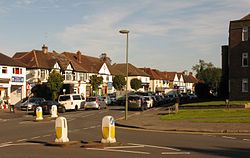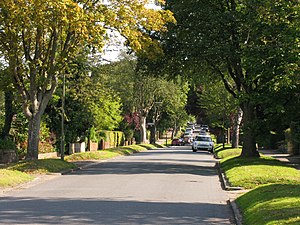Nork, Surrey
| Nork | |
| Surrey | |
|---|---|
 Shops in Nork | |
| Location | |
| Grid reference: | TQ241598 |
| Location: | 51°19’23"N, 0°13’12"W |
| Data | |
| Population: | 7,559 (2011) |
| Post town: | Banstead / Epsom |
| Postcode: | SM7 / KT17 |
| Dialling code: | 01737 |
| Local Government | |
| Council: | Reigate and Banstead |
| Parliamentary constituency: |
Epsom and Ewell |
Nork is a village of Surrey which has become little more than a residential area on the east side of Banstead, close to the looming edge of the metropolis. Nork is separated from Banstead only by the A217 dual carriageway, and the built-up area is also contiguous with similar parts of Tattenham Corner and Burgh Heath. A thin belt of more open land separates it from the communities to the north: Epsom, Ewell, Cheam and Belmont.
The village has two parades of shops, one called the Driftbridge and another at the north-eastern end of Nork Way, the street which runs centrally through the residential area. Nork lies on chalk near the top of the gentle north-facing slope of the North Downs.
History
The most likely explanation for the name 'Nork' is that it is from the Old English word for "nook", indicating a corner or a secluded, tranquil spot. Another proposed derivation is from "northern oak".[1]
The first recorded application of the name was to a "Nork close" (enclosed field) in 1723. It was then applied to Nork House, built in 1740 by Christopher Buckle (1684–1759).[2][3] The Buckle family were owners of the adjacent Burgh Manor from 1614 to 1847.[4] In the 18th and 19th centuries Nork could be considered an agricultural hamlet of Banstead village, covering the fields and buildings in the extensive grounds of Nork Park (surrounding Nork House). The line of trees planted to mark the park's northern boundary has given its name to Fir Tree Road.[2]
John Burton, author of Iter Surriense et Sussexiense, stayed at Nork House in 1752, and described at length the ingenious waterworks by which water was raised from a very deep well and distributed over the slopes of a dry down.[4]
In 1834 a celebrated highway robbery and murder occurred along what is now Yew Tree Bottom road where it joins the Reigate Road (Purcell's Gap). A Mr Richardson, returning from the Epsom cornmarket to Bletchingley, had dismounted on account of the steep climb, and was ambushed by two men whom he had considered suspicious on his outward trip that morning.[5][6] Later in that century the railway arrived (1865), primarily to serve Epsom Racecourse. Then in 1880 a large "cottage home" for children opened along the northern edge of Nork, between Fir Tree Road and the railway line. It was originally called "The Kensington and Chelsea District School" and later "Beechholme". At its peak, over 400 children were accommodated. The school closed in 1974 and the area was rebuilt with modern housing.[7][8]
In the 19th century, the Buckle family had sold their estates to the Perceval/Arden family, who in turn sold them to the Colman family, of mustard fame.[9] In 1923, the Nork estate was sold to a development company and Nork House itself was demolished in 1939.[10]
Housing development became rapid after 1923, and in 1925 the Nork Residents' Association was formed, publishing the Nork Quarterly, a bulletin that still appears regularly today.[9][11][12]
During Second World War, Nork received occasional damage from bombs, V-1 flying bombs and crashed aircraft. Some fortifications were built in preparation for an invasion, and later Canadian and British soldiers were stationed in Nork Park, occupying some of the buildings remaining from the estate as well as specially constructed Nissen huts.[13][14][15][16] After the war, the Nissen huts were utilised by the Council as temporary accommodation for council tenants, then demolished as tenants were moved into prefabs.[17]
Housing development continued after a break during the war. Amongst the last large-scale developments were the Rose Bushes estate in the 1960s and the High Beeches estate in the 1970s.[8][18] Recently, in-fill development has converted some of the large rear gardens of the original development into small housing schemes.
About the village
In a front garden along The Drive is a tumulus known as Tumble Beacon, which is a scheduled ancient monument. Originally it was a prehistoric bowl barrow, a funeral monument situated, as is typical, on one of the highest prominences in the region. At latest in Tudor times, it was built up to serve as a beacon where a fire would be lit to warn of the approach of hostile forces. In Second World War an air-raid shelter was dug inside.[19][20]
A group of Saxon burial mounds is to be found in the north part of Nork ward on the part of Banstead Downs west of the main A217 road. When one was excavated in 1972, archaeologists found late 7th, or possibly early 8th, century artefacts, including a spear, knife, shield boss, hanging bowl and textile. The primary burial was of a well built warrior and unusually tall at 6 feet, who was determeind to be a regular horse rider, probably in his late 20s. Another five skeletons appeared to be centuries-later victims of the mediæval gallows that gave rise to the local place name Gally Hills.[21][22][23]
In 1912 the Colman family rebuilt the mansion called Great Burgh, over the Reigate Road from Nork House. This neo-Georgian house is now a Grade II listed building.[24] It was used as a research establishment by the Distillers Company, then by British Petroleum and Beecham Pharmaceuticals, and later as offices and accommodation by Toyota, who have their UK headquarters here.[25][26] Since 2016, the original building has been occupied by the Science Group and their subsidiary Leatherhead Food Research.[26] The house's architect Ernest Newton also designed the formal gardens and parterres.[24][27]
Two estate cottages (Driftways and Crossways) remain near the Driftbridge, both built about 1890, and West Lodge, a flint-built gatehouse for Nork House on the Reigate Road.[28] A pair of 19th-century stone gate piers standing incongruously at the south end of Ruden Way are also from an entrance to the Nork Park estate.[28] The former Drift Bridge Hotel was built in 1931 in part of teak from HMS Ganges, the Royal Navy's last sail-driven flagship.[28]
The shopping parade at the end of Nork Way consists of small convenience stores and local services such as newsagents (including a post office), restaurants, motor mechanics, a baker's and a pharmacy.
-
Nork Way
-
Parade at Driftbridge
-
Church of St Paul
-
Interior of St Paul's
Churches
- Church of England: St Paul, in Warren Road, opened in 1930
- Methodist
- Roman Catholic
These three churches each have a church hall. Other venues for local events and indoor sports are the community centre in Nork Park off Nork Way and Scout Ridge near Banstead Station.
Outside links
- Nork Residents' Association
- Early pictures of Nork, particularly valuable for those of Nork House
- Francis Frith: photos, old OS map and anecdotes of Nork
- Francis Frith: photos and old OS map of Drift Bridge
- Oblique aerial photograph from 1921 showing Nork (in the background) before the housing development
References
- ↑ Anonymous. "Roads". Banstead History Research Group. http://www.bansteadhistory.com/roads_az.html. Retrieved 19 March 2015.
- ↑ 2.0 2.1 Banstead History Research Group (2005). The history of Banstead Vol. I: the "olden days". From the Romans to Queen Victoria. Banstead History Research Group. ISBN 0951274171.
- ↑ Sweetman, J.. "The Buckle Family". Banstead History Research Group. http://www.bansteadhistory.com/people_az.html. Retrieved 29 September 2015.
- ↑ 4.0 4.1 A History of the County of Surrey - Volume 3 pp 252-262: Parishes: Banstead (Victoria County History)
- ↑ Anonymous. "Horrid murder and highway robbery". Epsom and Ewell History Explorer. http://www.epsomandewellhistoryexplorer.org.uk/HorridMurder.html. Retrieved 19 October 2015.
- ↑ Van der Kiste, John (2009). Surrey Murders. Stroud: The History Press. ISBN 978-0750951302.
- ↑ Maciejewski, R. (2010). Beecholme: a children's village. Banstead History Research Group. ISBN 978-0-9550768-4-8.
- ↑ 8.0 8.1 Higginbotham, Peter. "Kensington & Chelsea School District: Banstead Cottage Homes". http://www.workhouses.org.uk/KensingtonAndChelseaSD/. Retrieved 15 October 2015.
- ↑ 9.0 9.1 Banstead History Research Group (2005). The history of Banstead Vol. II: how a village grew and changed. Banstead History Research Group. ISBN 0951274198.
- ↑ Old Surrey Downs Project. "Town and Down Circular Walk". Reigate and Banstead Borough Council. http://www.reigate-banstead.gov.uk/Images/53722_Walk%20Leaflet_tcm9-38032.pdf. Retrieved 5 March 2015.
- ↑ "The Residents' Association: how it all began". Nork Residents' Association. http://www.nork-residents.org.uk/history.html. Retrieved 4 March 2015.
- ↑ "Nork Quarterly". Nork Residents' Association. http://www.nork-residents.org.uk/nork-quarterly.html. Retrieved 20 January 2019.
- ↑ Robinson, Geoffrey. "Me and the war in Banstead (part one)". BBC, Banstead History Centre. https://www.bbc.co.uk/history/ww2peopleswar/stories/35/a7858335.shtml. Retrieved 19 March 2015.
- ↑ Robinson, Geoffrey. "Me and the war in Banstead (part two)". BBC, Banstead History Centre. https://www.bbc.co.uk/history/ww2peopleswar/stories/81/a7859181.shtml. Retrieved 19 March 2015.
- ↑ Robinson, Geoffrey. "Me and the war in Banstead (part three)". BBC, Banstead History Centre. https://www.bbc.co.uk/history/ww2peopleswar/stories/37/a7859037.shtml. Retrieved 16 October 2015.
- ↑ Skinner, D., Smith, J., Wilman, R., Christie, L., Forth, J., Slaughter, T., Woodman, M. "Banstead wartime memories". Banstead History Research Group. http://www.bansteadhistory.com/War%20Memories/War_memories_main_page.html.
- ↑ Anonymous. "Nork Park". Reigate and Banstead Borough Council. http://www.reigate-banstead.gov.uk/info/20042/parks_and_countryside/669/nork_park. Retrieved 17 October 2015.
- ↑ Anonymous. "Property history of 22 Rose Bushes, Epsom KT17 3NX, 18th Aug 2014". Zoopla. http://www.zoopla.co.uk/property-history/22-rose-bushes/epsom/kt17-3nx/34246739. Retrieved 15 October 2015.
- ↑ National Heritage List 1009804: Bowl barrow and later beacon at Tumble Beacon (Scheduled ancient monument entry)
- ↑ Renn, Derek (29 April 2004). "Untitled". Leatherhead Advertiser. http://www.leatherheadlocalhistory.org.uk/2004.htm. Retrieved 5 March 2015.
- ↑ National Heritage List 1008054: Two Saxon burial mounds on Gally Hills, west of Brighton Road (Scheduled ancient monument entry)
- ↑ Barfoot, J.F.; Price Williams, D. (1976). "The Saxon barrow at Gally Hills, Banstead Down, Surrey". Surrey Archaeological Society Research Volumes 3: 59–76. http://archaeologydataservice.ac.uk/archives/view/surreyrv/contents.cfm?vol_id=980.
- ↑ Reynolds, A. (2009). Anglo-Saxon Deviant Burial Customs. Oxford University Press. pp. 137–138. ISBN 9780191567650. https://books.google.com/books?id=vIbwXW6MPRoC.
- ↑ 24.0 24.1 National Heritage List 1029020: Great Burgh (Grade II listing)
- ↑ Savills Marketing. "Great Burgh, Epsom". Savills. http://commercialsearch.savills.co.uk/content/assets/2975/Great%20Burgh,%20Epsom.pdf. Retrieved 5 March 2015.
- ↑ 26.0 26.1 Foster, Alice (13 November 2015). "Leatherhead Research in £9M move to near Epsom". FoodManufacture.co.uk. http://www.foodmanufacture.co.uk/Manufacturing/Food-research-firm-relocates. Retrieved 14 April 2016.
- ↑ McInally, John (2001). The list of historic parks & gardens: supplementary planning guidance. Reigate and Banstead Borough Council, Department of Policy and Environment. http://www.reigate-banstead.gov.uk/download/downloads/id/97/supplementary_planning_guidance#. Retrieved 10 October 2015.
- ↑ 28.0 28.1 28.2 Buildings & development services information (2014). List of buildings of architectural and historic interest (6th ed.). Reigate and Banstead Borough Council. http://www.reigate-banstead.gov.uk/downloads/file/380/view_the_list_of_buildings_of_architectural_and_historic_interest. Retrieved 11 October 2015.



